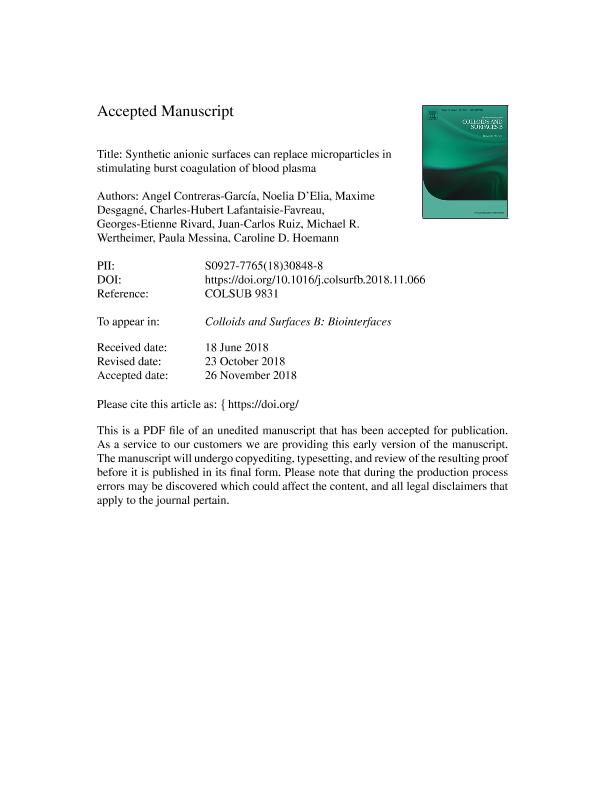Artículo
Synthetic anionic surfaces can replace microparticles in stimulating burst coagulation of blood plasma
Contreras García, Angel; D'elía, Noelia Laura ; Desgagné, Maxime; Lafantaisie Favreau, Charles Hubert; Rivard, Georges Étienne; Ruiz, Juan Carlos; Wertheimer, Michael Robert; Messina, Paula Verónica
; Desgagné, Maxime; Lafantaisie Favreau, Charles Hubert; Rivard, Georges Étienne; Ruiz, Juan Carlos; Wertheimer, Michael Robert; Messina, Paula Verónica ; Hoemann, Caroline Dieckmann
; Hoemann, Caroline Dieckmann
 ; Desgagné, Maxime; Lafantaisie Favreau, Charles Hubert; Rivard, Georges Étienne; Ruiz, Juan Carlos; Wertheimer, Michael Robert; Messina, Paula Verónica
; Desgagné, Maxime; Lafantaisie Favreau, Charles Hubert; Rivard, Georges Étienne; Ruiz, Juan Carlos; Wertheimer, Michael Robert; Messina, Paula Verónica ; Hoemann, Caroline Dieckmann
; Hoemann, Caroline Dieckmann
Fecha de publicación:
01/03/2019
Editorial:
Elsevier Science
Revista:
Colloids and Surfaces B: Biointerfaces
ISSN:
0927-7765
Idioma:
Inglés
Tipo de recurso:
Artículo publicado
Clasificación temática:
Resumen
Biomaterials are frequently evaluated for pro-coagulant activity but usually in the presence of microparticles (MPs), cell-derived vesicles in blood plasma whose phospholipid surfaces allow coagulation factors to set up as functional assemblies. We tested the hypothesis that synthetic anionic surfaces can catalyze burst thrombin activation in human blood plasma in the absence of MPs. In a thromboelastography (TEG) assay with plastic sample cups and pins, recalcified human citrated platelet-poor plasma spontaneously burst-coagulated but with an unpredictable clotting time whereas plasma depleted of MPs by ultracentrifugation failed to coagulate. Coagulation of MP-depleted plasma was restored in a dose-dependent manner by glass microbeads, hydroxyapatite nanoparticles (HA NPs), and carboxylic acid-containing anionic nanocoatings of TEG cups and pins (coated by glow-discharge plasma-polymerized ethylene containing oxygen, L-PPE:O with 4.4 and 6.8 atomic % [COOH]). Glass beads lost their pro-coagulant activity in MP-depleted plasma after their surfaces were nanocoated with hydrophobic plasma-polymerized hexamethyl disiloxane (PP-HMDSO). In FXII-depleted MP-depleted plasma, glass microbeads failed to induce coagulation, however, FXIa was sufficient to induce coagulation in a dose-dependent manner, with no effect of glass beads. These data suggest that anionic surfaces of crystalline, organic, and amorphous solid synthetic materials catalyze explosive thrombin generation in MP-depleted plasma by activating the FXII-dependent intrinsic contact pathway. The data also show that microparticles are pro-coagulant surfaces whose activity has been largely overlooked in many coagulation studies to-date. These results suggest a possible mechanism by which anionic biomaterial surfaces induce bone healing by contact osteogenesis, through fibrin clot formation in the absence of platelet activation.
Archivos asociados
Licencia
Identificadores
Colecciones
Articulos(INQUISUR)
Articulos de INST.DE QUIMICA DEL SUR
Articulos de INST.DE QUIMICA DEL SUR
Citación
Contreras García, Angel; D'elía, Noelia Laura; Desgagné, Maxime; Lafantaisie Favreau, Charles Hubert; Rivard, Georges Étienne; et al.; Synthetic anionic surfaces can replace microparticles in stimulating burst coagulation of blood plasma; Elsevier Science; Colloids and Surfaces B: Biointerfaces; 175; 1-3-2019; 596-605
Compartir
Altmétricas



